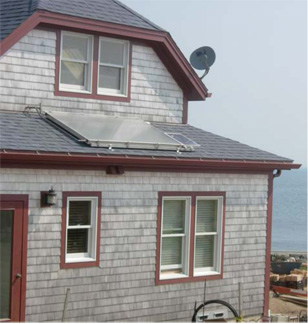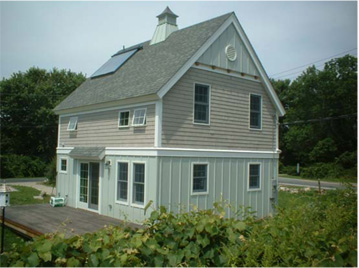Economics and Examples
Often the most cost-effective way to install a renewable energy system is at the initial time of construction. This reduces the cost of running pipes, conduit, and conductors. Also, when evaluating economics, one should consider alternative investments that are available. Investing in renewable energy provides superior returns to many other kinds of investments, and at a much lower risk.
The U.S. Department of Energy (DOE) Solar Energy Technologies Office (SETO) has detailed information on renewable energy systems:
https://www.energy.gov/eere/solar/solar-energy-technologies-office
An introductory part of their website describing various technologies can be found here:
https://www.energy.gov/eere/solar/how-does-solar-work
Solar Electric Systems
Solar Electric systems, also known as photovoltaic (PV) systems convert solar energy into electricity. These systems can be used to supply all of a building's electricity needs or can run in parallel with the local utility in order to use the utility's energy when necessary. The inclusion of a battery system will enable excess solar generated electricity to be stored as a back-up source of energy if the local utility has a power outage. Similar to solar thermal systems, the solar electric modules can be mounted on the roof or ground or integrated into the building as part of the structure. A 3,000 watt solar electric system can supply approximately 60% of a typical family of four's annual electricity requirements.
Maintenance of a solar electric system is dependent upon the equipment installed, especially when batteries are included. Most owners of solar electric systems are very attentive the first year the system is in place. As time goes on, often the owners consider the system like any other appliance and the time between maintenance cycles increases. We recommend a semi-annual maintenance cycle that includes inspection of the electrical connections for corrosion or loose fittings, testing the batteries' specific gravity, adding distilled water to batteries (if included in the design, and using a flooded battery type.)

Examples of Solar Electric Economics for Residential or Small Commercial Systems
The owners of a house investigate the installation of a solar electric system by considering a design that is modular and can be expanded at a relatively low cost. They decide to install 6,000 watts of solar power, but to specify an inverter that capacity for 10,000 watts. This system has ample capacity for expansion, and in the future, solar electric modules can be added using the existing inverter. They also specify an inverter that can integrate batteries as energy storage for future planning.
Residential Solar Electric without Batteries
Cost |
|
| Installation Cost | $22,800 |
| Renewable Grant (1) | ($3,900) |
| Federal Tax Credit (2) | ($6,840) |
| SState Tax Credit (3) | $0 |
| Actual Installed Cost | $12,060 |
| Average Annual Savings (4): | $2,698 |
| Simple Payback, years: | |
| (Actual Installed Cost ÷ Average Annual Savings) | 4.5 |
| SSimple Return on Investment: 1/4.5 | 22% |
(1) RI Renewable Grant - $.65/watt +$2,000 for batteries
(2) Federal ITC- Residential, 30% of cost
(3) State ITC - Not Applicable in Rhode Island
(4) Ten-year average at $.26/kWh increasing 3% annually
Depreciation for Commercial Systems improves the Return on Investment
The owners of a house investigate the installation of a solar electric system with batteries. They decide to install 6,000 watts of solar power, with 700 amp-hours of battery capacity. This system can operate their critical loads for up to three days on solar and batteries alone. The annual value of having battery backup energy is estimated by the homeowner to be $850 in saved food, adequate water and heating and communication capabilities.
Residential Solar Electric with Batteries
Cost |
|
| Installation Cost | $30,900 |
| Renewable Grant (1) | ($5,900) |
| Federal Tax Credit (2) | ($9,270) |
| SState Tax Credit (3) | $0 |
| Actual Installed Cost | $15,730 |
| Average Annual Savings (4): | $3,548 |
| Simple Payback, years: | |
| (Actual Installed Cost ÷ Average Annual Savings) | 4.4 |
| SSimple Return on Investment: 1/4.4 | 23% |
(1) RI Renewable Grant - $.65/watt +$2,000 for batteries
(2) Federal ITC- Residential, 30% of cost
(3) State ITC - Not Applicable in Rhode Island
(4) Ten-year average at $.26/kWh increasing 3% annually +$850
Enrolling in utility demand response plan will increase savings.
Depreciation for Commercial Systems improves the Return on Investment
Example of Solar Thermal Economics for Residential or Small Commercial Systems
Solar Thermal systems capture the sun's energy, using it to heat liquid or air. The majority of solar heated liquid is used to heat domestic water for uses in showers, laundry, dishes and pools. Two nominal 4x8 collectors will provide 75% or greater of the annual domestic water needs for a family of four. Most solar assisted domestic water heating systems use flat plate technology.

An increasingly popular and cost-effective way to use solar heated fluid is in radiant space heating systems. Most solar assisted radiant floor systems use evacuated tube technology.

Maintenance of a solar thermal system is required as with any other appliance, and is simple and straightforward. All that is usually necessary is a semiannual check of the system's fluid quality by measuring its pH. A visual inspection of the piping system and pump should also be undertaken at this time. The inspection will take less than one hour.
Example of Solar Water Heating Economics
The owner of a home is considering the use of solar water heating to reduce the expense of heating domestic water with fossil fuel. For a family of four, they decide to install 2, 30 ft2 collectors.
Residential Solar Water Heating System
Cost |
|
| Installation Cost | $9,600 |
| Renewable Grant (1) | ($2,400) |
| Federal Tax Credit (2) | ($2,880) |
| SState Tax Credit (3) | $0 |
| Actual Installed Cost | $4,320 |
| Average Annual Savings (4): | $925 |
| Simple Payback, years: | |
| (Actual Installed Cost ÷ Average Annual Savings) | 4.7 |
| SSimple Return on Investment: 1/4.7 | 21% |
(1) RI Renewable Grant - Lesser of 25% of cost, or $4,000
(2) Federal ITC- Residential, 30% of cost
(3) State ITC - Not Applicable in Rhode Island
(4) Ten-year average at $925
Depreciation for Commercial Systems improves the Return on Investment
